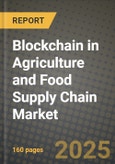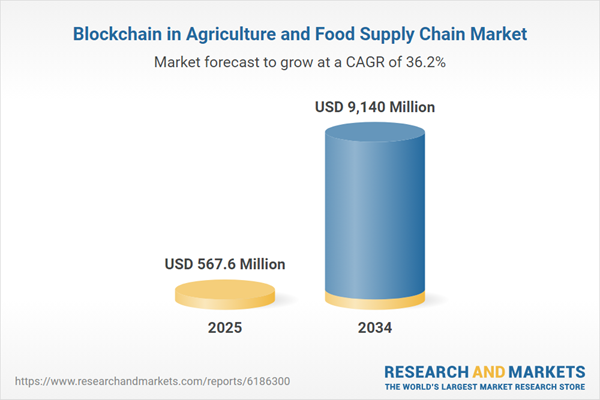The Blockchain in Agriculture and Food Supply Chain Market is steadily growing as stakeholders increasingly recognize the potential of blockchain technology to enhance transparency, efficiency, and trust throughout the supply chain. By providing a decentralized and tamper-proof ledger, blockchain enables more reliable traceability of food products from farm to table. This is particularly important as consumers, retailers, and regulatory bodies demand higher standards of safety, authenticity, and sustainability in the food supply chain.
Key drivers of growth include increasing incidences of foodborne illnesses, rising consumer awareness of sustainable practices, and the need to combat food fraud. Blockchain solutions allow for the quick identification of contamination sources, which helps to reduce recall times and associated costs. Additionally, the technology is being used to verify organic and fair-trade certifications, ensure proper storage conditions, and enhance collaboration between farmers, processors, distributors, and retailers.
Despite these benefits, the market faces challenges such as the high cost of implementation, technical complexity, and the need for widespread industry collaboration. However, as technology advances, costs decrease, and the benefits of blockchain adoption become more evident, the Blockchain in Agriculture and Food Supply Chain Market is expected to see continued growth and innovation.
Key Insights: Blockchain In Agriculture and Food Supply Chain Market
- Rising adoption of blockchain platforms to ensure food safety and traceability.
- Growing focus on using blockchain for verifying sustainability and ethical sourcing.
- Expansion of pilot projects to full-scale implementations in large agribusinesses.
- Increasing integration with IoT devices and sensors for real-time data capture.
- Development of industry-specific blockchain consortia to standardize processes and protocols.
- Rising consumer demand for transparency and authenticity in the food supply chain.
- Increasing regulatory requirements for food safety and traceability.
- Enhanced ability to reduce food waste and recall costs.
- Growing investment in agricultural technology and digital transformation initiatives.
- High costs associated with implementing blockchain solutions.
- Technical complexity and the need for specialized expertise.
- Limited interoperability between different blockchain systems and existing IT infrastructure.
- Resistance to change among some industry participants.
Blockchain In Agriculture and Food Supply Chain Market Segmentation
By Type
- Public Blockchain
- Private Blockchain
- Consortium/Hybrid Blockchain
By Stakeholder
- Growers
- Food Manufacturers/Processors
- Retailers
By Application
- Product Traceability
- Tracking
- and Visibility
- Payment and Settlement
- Smart Contracts
- Governance
- Risk and Compliance Management
Key Companies Analysed
- International Business Machines Corporation
- Microsoft Corporation
- SAP SE
- Ambrosus AG
- Arc-net
- OriginTrail Ltd.
- Rip. io
- Provenance Ltd.
- Chainvine Limited (ChainVine)
- AgriDigital Pty Ltd.
- Riiot Labs SA
- VeChain Foundation
- BlockGrain
- AgriChain Pty Ltd.
- TE-FOOD International GmbH
- Agri 10x LLC
- AgriLedger Ltd.
- AgroChain Ltd.
- Bext Holdings Inc.
- Cargill Incorporated
- CropIn Technology Solutions Pvt. Ltd.
- Deere & Company
- Eka Software Solutions Pvt. Ltd.
- Emerson Electric Co.
- FoodLogiQ LLC
- Full Profile Pty Ltd
- GrainChain Inc.
- Kisan Network
- Modi Infosol Pvt. Ltd.
- Nestlé S. A.
- Ripe Technology Inc.
- The Seam LLC
- Topl LLC
- Trace Genomics Inc.
- Unilever PLC
- Viant Technology LLC
- Walmart Inc.
- Yara International ASA
- Zume Inc.
Blockchain In Agriculture and Food Supply Chain Market Analytics
The report employs rigorous tools, including Porter’s Five Forces, value chain mapping, and scenario-based modeling, to assess supply-demand dynamics. Cross-sector influences from parent, derived, and substitute markets are evaluated to identify risks and opportunities. Trade and pricing analytics provide an up-to-date view of international flows, including leading exporters, importers, and regional price trends.Macroeconomic indicators, policy frameworks such as carbon pricing and energy security strategies, and evolving consumer behavior are considered in forecasting scenarios. Recent deal flows, partnerships, and technology innovations are incorporated to assess their impact on future market performance.
Blockchain In Agriculture and Food Supply Chain Market Competitive Intelligence
The competitive landscape is mapped through proprietary frameworks, profiling leading companies with details on business models, product portfolios, financial performance, and strategic initiatives. Key developments such as mergers & acquisitions, technology collaborations, investment inflows, and regional expansions are analyzed for their competitive impact. The report also identifies emerging players and innovative startups contributing to market disruption.Regional insights highlight the most promising investment destinations, regulatory landscapes, and evolving partnerships across energy and industrial corridors.
Countries Covered
- North America - Blockchain In Agriculture and Food Supply Chain market data and outlook to 2034
- United States
- Canada
- Mexico
- Europe - Blockchain In Agriculture and Food Supply Chain market data and outlook to 2034
- Germany
- United Kingdom
- France
- Italy
- Spain
- BeNeLux
- Russia
- Sweden
- Asia-Pacific - Blockchain In Agriculture and Food Supply Chain market data and outlook to 2034
- China
- Japan
- India
- South Korea
- Australia
- Indonesia
- Malaysia
- Vietnam
- Middle East and Africa - Blockchain In Agriculture and Food Supply Chain market data and outlook to 2034
- Saudi Arabia
- South Africa
- Iran
- UAE
- Egypt
- South and Central America - Blockchain In Agriculture and Food Supply Chain market data and outlook to 2034
- Brazil
- Argentina
- Chile
- Peru
Research Methodology
This study combines primary inputs from industry experts across the Blockchain In Agriculture and Food Supply Chain value chain with secondary data from associations, government publications, trade databases, and company disclosures. Proprietary modeling techniques, including data triangulation, statistical correlation, and scenario planning, are applied to deliver reliable market sizing and forecasting.Key Questions Addressed
- What is the current and forecast market size of the Blockchain In Agriculture and Food Supply Chain industry at global, regional, and country levels?
- Which types, applications, and technologies present the highest growth potential?
- How are supply chains adapting to geopolitical and economic shocks?
- What role do policy frameworks, trade flows, and sustainability targets play in shaping demand?
- Who are the leading players, and how are their strategies evolving in the face of global uncertainty?
- Which regional “hotspots” and customer segments will outpace the market, and what go-to-market and partnership models best support entry and expansion?
- Where are the most investable opportunities - across technology roadmaps, sustainability-linked innovation, and M&A - and what is the best segment to invest over the next 3-5 years?
Your Key Takeaways from the Blockchain In Agriculture and Food Supply Chain Market Report
- Global Blockchain In Agriculture and Food Supply Chain market size and growth projections (CAGR), 2024-2034
- Impact of Russia-Ukraine, Israel-Palestine, and Hamas conflicts on Blockchain In Agriculture and Food Supply Chain trade, costs, and supply chains
- Blockchain In Agriculture and Food Supply Chain market size, share, and outlook across 5 regions and 27 countries, 2023-2034
- Blockchain In Agriculture and Food Supply Chain market size, CAGR, and market share of key products, applications, and end-user verticals, 2023-2034
- Short- and long-term Blockchain In Agriculture and Food Supply Chain market trends, drivers, restraints, and opportunities
- Porter’s Five Forces analysis, technological developments, and Blockchain In Agriculture and Food Supply Chain supply chain analysis
- Blockchain In Agriculture and Food Supply Chain trade analysis, Blockchain In Agriculture and Food Supply Chain market price analysis, and Blockchain In Agriculture and Food Supply Chain supply/demand dynamics
- Profiles of 5 leading companies - overview, key strategies, financials, and products
- Latest Blockchain In Agriculture and Food Supply Chain market news and developments
Additional Support
With the purchase of this report, you will receive:- An updated PDF report and an MS Excel data workbook containing all market tables and figures for easy analysis.
- 7-day post-sale analyst support for clarifications and in-scope supplementary data, ensuring the deliverable aligns precisely with your requirements.
- Complimentary report update to incorporate the latest available data and the impact of recent market developments.
This product will be delivered within 1-3 business days.
Table of Contents
Companies Mentioned
- International Business Machines Corporation
- Microsoft Corporation
- SAP SE
- Ambrosus AG
- Arc-net
- OriginTrail Ltd.
- Rip. io
- Provenance Ltd.
- Chainvine Limited (ChainVine)
- AgriDigital Pty Ltd.
- Riiot Labs SA
- VeChain Foundation
- BlockGrain
- AgriChain Pty Ltd.
- TE-FOOD International GmbH
- Agri 10x LLC
- AgriLedger Ltd.
- AgroChain Ltd.
- Bext Holdings Inc.
- Cargill Incorporated
- CropIn Technology Solutions Pvt. Ltd.
- Deere & Company
- Eka Software Solutions Pvt. Ltd.
- Emerson Electric Co.
- FoodLogiQ LLC
- Full Profile Pty Ltd.
- GrainChain Inc.
- Kisan Network
- Modi Infosol Pvt. Ltd.
- Nestlé S. A.
- Ripe Technology Inc.
- The Seam LLC
- Topl LLC
- Trace Genomics Inc.
- Unilever PLC
- Viant Technology LLC
- Walmart Inc.
- Yara International ASA
- Zume Inc.
Table Information
| Report Attribute | Details |
|---|---|
| No. of Pages | 160 |
| Published | October 2025 |
| Forecast Period | 2025 - 2034 |
| Estimated Market Value ( USD | $ 567.6 Million |
| Forecasted Market Value ( USD | $ 9140 Million |
| Compound Annual Growth Rate | 36.1% |
| Regions Covered | Global |
| No. of Companies Mentioned | 39 |









